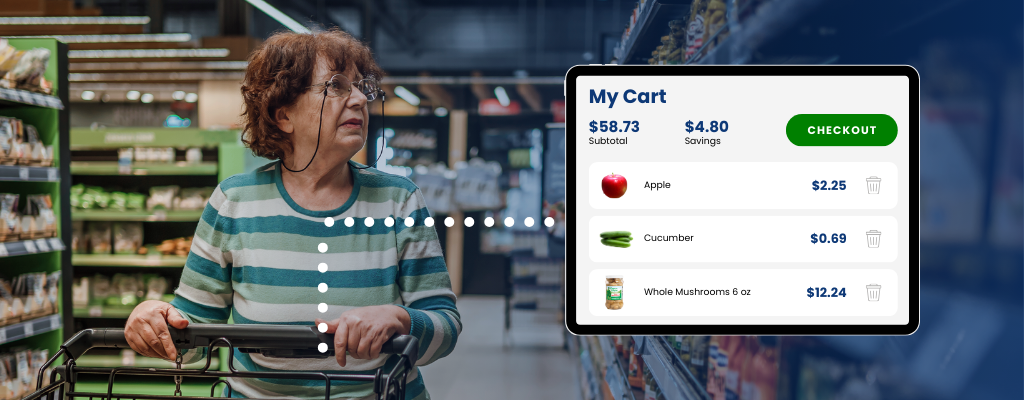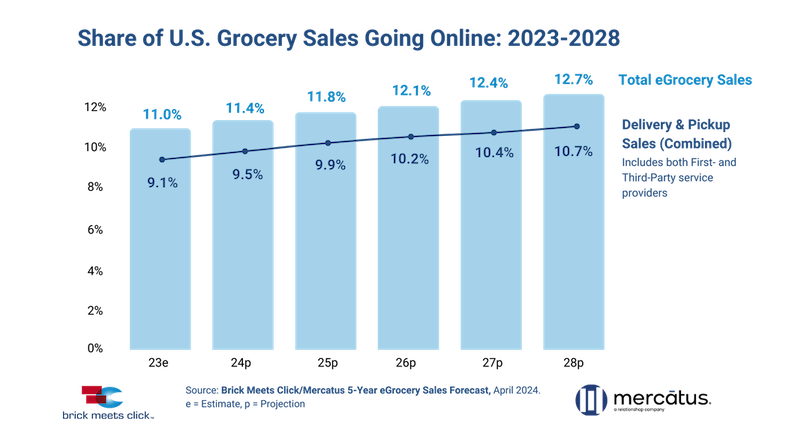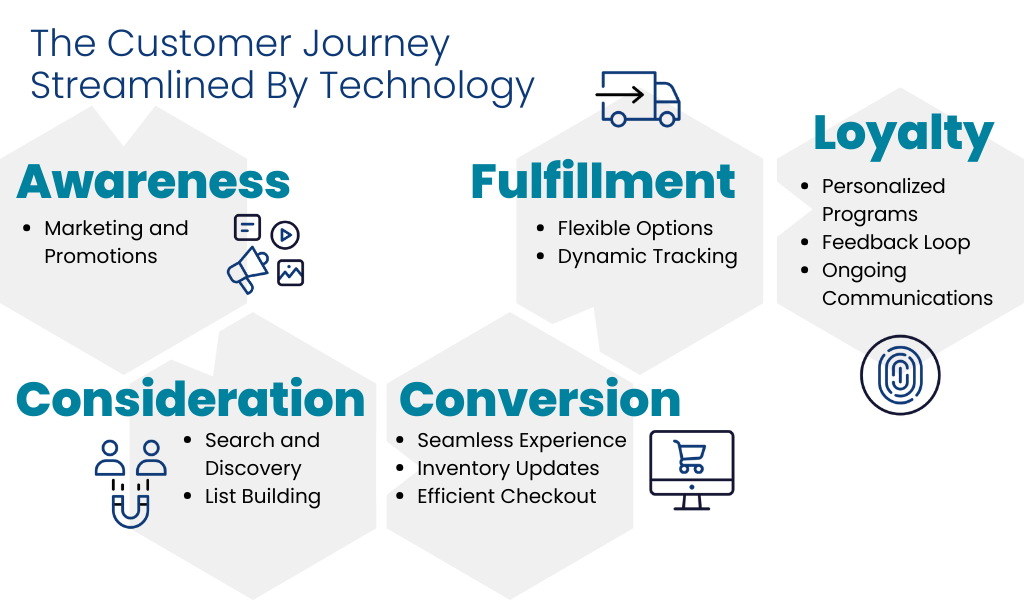Introduction
Grocery personalization has become a critical strategy for improving customer experience and driving customer loyalty. As consumer preferences develop, traditional grocers are increasingly adopting digital grocery solutions to meet the growing demand for personalized services. The integration of AI in retail and machine learning for groceries allows retailers to customize offerings to individual customer needs, thereby improving satisfaction and engagement. Grocery personalization not only enriches the shopping experience by providing customized recommendations and offers but also helps retailers stay ahead in the rapidly changing market.
Understanding the importance of grocery personalization is essential for grocers looking to adapt to modern consumer behavior. By utilizing big data in retail and advanced analytics, retailers can gain insights into consumer behavior analysis and deliver a smart shopping experience to all their individual customers. This approach not only boosts ecommerce sales but also enhances the overall efficiency and effectiveness of online grocery shopping. As we delve deeper into the benefits and strategies of grocery personalization, it becomes clear that this trend is reshaping the future of the grocery industry.
Benefits of Personalized Grocery Shopping
Grocery personalization offers numerous advantages for both customers and retailers. It improves the shopping experience by addressing individual needs and preferences. By leveraging digital grocery solutions and advanced machine learning for groceries, retailers can enhance the value provided to their customers, leading to increased satisfaction, higher order values, and stronger loyalty.

Increased Customer Satisfaction
Personalized grocery shopping significantly raises customer satisfaction. Shoppers appreciate when their preferences are understood and met. This personalized attention makes customers feel valued and improves their overall experience.
Customized Recommendations
Personalized recommendations cater to individual tastes and habits. By analyzing past purchase data, retailers can predict what products customers might be interested in. These tailored suggestions make shopping more convenient and enjoyable.
- Suggested products based on past purchases: Recommending products that align with previous shopping habits helps customers find what they need quickly.
- Recommendations for related items: Offering complementary products enhances the shopping experience by providing useful suggestions.
- Customized offers and discounts: Tailored discounts make customers feel special and encourage repeat purchases.
Higher Average Order Values
Grocery personalization often leads to higher average order values. By offering relevant product suggestions, customers are more likely to add additional items to their carts. This increase in order size benefits both the retailer and the customer by making shopping trips more productive.
Cross-Selling Opportunities
Personalized shopping creates cross-selling opportunities. This strategy involves suggesting related products that complement the items in a customer's cart. These strategies encourage customers to explore more products.
- Recommending complementary products: Suggesting items that pair well with what the customer is already buying encourages additional purchases.
- Highlighting popular items that match purchase history: Drawing attention to best-sellers that align with past purchases can tempt customers to try new products.
- Offering exclusive deals on frequently bought items: Exclusive discounts on regularly purchased items encourage larger orders.
Increased Spending
Customers tend to spend more when they receive personalized offers. These targeted promotions make customers feel like they are getting good value for their money.
- Discounts on bulk purchases: Offering savings on larger quantities incentivizes customers to buy more.
- Promotions on new products similar to past purchases: Introducing new items that fit customer preferences can lead to increased spending.
- Incentives for higher spending thresholds: Rewards for reaching certain spending limits encourage customers to increase their order size.
These incentives boost overall spending during each shopping trip.
Boost in Customer Loyalty
Personalized grocery shopping strengthens customer loyalty. When customers feel valued, they are more likely to return. Building loyalty is crucial for long-term success in the retail market. Effective loyalty programs are a key aspect of grocery personalization. These programs are designed to reward customers for their continued patronage.
- Personalized rewards based on shopping behavior: Customizing rewards to fit individual shopping habits makes the program more appealing.
- Exclusive access to special promotions: Offering members-only deals encourages customers to stay loyal.
- Points systems tailored to individual preferences: Allowing customers to earn points for purchases that can be redeemed for products they like enhances satisfaction.
Grocery personalization is essential for modern retailers. It increases satisfaction, boosts order values, and strengthens loyalty, making it a critical strategy for success in the competitive grocery market.
Importance of Grocery Personalization
Grocery personalization is crucial for retailers aiming to meet modern consumer expectations. By incorporating personalized experiences, grocers can better serve their customers and stay ahead in a competitive market. This section explores the importance of adapting traditional grocery models, leveraging technology, and gaining a competitive advantage through grocery personalization.
Adapting Traditional Grocery Models to Modern Needs
Traditional grocery models focus on in-store experiences and broad marketing strategies. However, modern consumers demand more personalized and convenient shopping experiences. Adapting these traditional models to include personalization is essential for meeting these evolving needs.
Incorporating Digital Tools
Digital tools are fundamental in adapting traditional grocery models. Modern consumers are increasingly relying on technology to simplify their shopping experiences. By integrating these digital tools, grocers can offer more convenience and better service.
- Online grocery shopping: Providing an easy-to-navigate online platform enhances convenience for customers.
- Grocery delivery services: Offering delivery options caters to the need for convenience and accessibility.
- Digital grocery store: Integrating digital solutions in physical stores bridges the gap between online and offline shopping.
These adaptations help traditional grocers meet the expectations of today's consumers.
Personalizing In-Store Experiences
Personalizing in-store experiences can improve customer satisfaction and loyalty. Shoppers value a personalized touch, even when visiting physical stores, as it makes their shopping more efficient and enjoyable.
- Customized shopping lists: Offering tools for creating personalized shopping lists based on past purchases.
- In-store recommendations: Using data to suggest products during the shopping trip enhances the in-store experience.
- Exclusive in-store promotions: Providing personalized offers and discounts to in-store shoppers.
These strategies make in-store shopping more enjoyable and efficient.
Developing Technology for Enriched Personalization
Developing technology is key to providing enriched personalization. Advanced tools and platforms enable grocers to deliver more accurate and relevant experiences. Investing in these technologies is essential for staying competitive.
Utilizing AI and Machine Learning
AI in retail and machine learning for groceries are powerful tools for enhancing personalization. These technologies analyze vast amounts of data to provide insights into consumer behavior, helping retailers offer more precise and timely recommendations.
- Consumer behavior analysis: Analyzing shopping patterns to understand customer preferences.
- Predictive analytics: Using data to predict future purchases and offer timely recommendations.
- Automated personalization: Implementing systems that automatically personalize offers and communications.
These technologies enable a deeper understanding of customer needs. Engaged customers are more likely to return and remain loyal.
Integrating Personalization Platforms
Personalization platforms help manage and deliver tailored experiences. These platforms streamline various personalization efforts, ensuring consistency and efficiency across different channels.
- eCommerce personalization platform: Enhancing the online shopping experience with personalized recommendations.
- Retail personalization: Applying personalized marketing strategies across all customer touchpoints.
- Digital grocery solutions: Implementing comprehensive solutions that integrate personalization into all aspects of the grocery business.
These platforms streamline the personalization process and improve efficiency.

Competitive Advantage in the Grocery Market
Grocery personalization provides a significant competitive advantage. By offering a personalized shopping experience, grocers can differentiate themselves from competitors and attract more customers. This differentiation is key to attracting and retaining a loyal customer base.
Increasing Market Share
Personalization helps grocers capture a larger share of the market. By understanding and meeting individual customer needs, grocers can attract new shoppers and retain existing ones.
- Grocery ecommerce: Expanding online presence with personalized online shopping experiences.
- Online grocery platform: Providing a seamless and personalized online shopping platform.
- Grocery loyalty programs: Implementing loyalty programs that reward personalized shopping behavior.
Grocery personalization is essential for modern retailers. By adapting traditional models, leveraging technology, and gaining a competitive edge, grocers can meet the needs of today’s consumers and thrive in a competitive market.
Enriching User Preferences in Grocery Shopping
Grocery personalization allows retailers to better understand and cater to individual customer preferences. By leveraging data and advanced technologies, grocers can create a more engaging and satisfying shopping experience. This section discusses how using data, personalizing offers, and improving the shopping experience can enrich user preferences.
Using Data to Understand Customer Preferences
Understanding customer preferences is the first step in grocery personalization. By analyzing data, retailers can gain insights into shopping behaviors, preferences, and trends. This data-driven approach helps in creating a more personalized shopping experience.
Data Analysis Techniques
Various techniques are used to analyze customer data and extract valuable insights. These methods help retailers understand what their customers want and need.
- Consumer behavior analysis: Examining past purchase patterns to identify trends and preferences.
- Big data in retail: Utilizing large datasets to gain comprehensive insights into customer behavior.
- Predictive analytics: Anticipating future customer needs based on historical data.
These techniques provide a solid foundation for personalizing the shopping experience.
Personalizing Offers and Recommendations
Personalizing offers and recommendations is a crucial aspect of grocery personalization. Tailored promotions and suggestions make customers feel valued and understood, which enhances their shopping experience.
Improving the Overall Shopping Experience
Improving the overall shopping experience involves more than just personalizing offers. It includes making the shopping process smoother and more enjoyable for customers. This can be achieved through various strategies and tools.
Enhancing Shopping Tools
Enhancing the tools and features available to customers can significantly improve their shopping experience. These tools help make the shopping process more convenient and efficient. These tools and features enhance the overall shopping experience for customers.
- Smart shopping solutions: Offering advanced tools that simplify the shopping process.
- Grocery shopping app: Providing a user-friendly app with personalized features and recommendations.
- Online grocery service: Ensuring a seamless online shopping experience with personalized services.
Grocery personalization is essential for enriching user preferences in grocery shopping. By using data to understand customer preferences, personalizing offers and recommendations, and improving the overall shopping experience, retailers can create a more engaging and satisfying shopping experience for their customers. This personalized approach helps build stronger customer relationships and increases loyalty.
Data-Driven Solutions for Personalized Grocery Shopping
Grocery personalization relies heavily on data-driven solutions to deliver a tailored shopping experience. By implementing advanced technologies such as AI and machine learning, integrating digital solutions, and utilizing predictive personalization, retailers can significantly enhance the shopping experience for their customers. Grocery personalization is driven by data and advanced technologies. Implementing AI and machine learning, integrating digital solutions seamlessly, and leveraging predictive personalization are essential strategies for providing a personalized shopping experience.
Implementing AI and Machine Learning
AI and machine learning are at the forefront of grocery personalization. These technologies analyze vast amounts of data to provide insights that help retailers understand and predict customer behavior. This enables grocers to offer more relevant and timely personalized experiences.
AI and Machine Learning Applications
AI and machine learning have various applications in personalized grocery shopping. These applications help retailers provide a more customized shopping experience.
- Consumer behavior analysis: AI algorithms analyze past purchase data to identify patterns and preferences.
- Automated personalization: Machine learning models generate personalized recommendations and offers.
- Real-time data processing: AI processes data in real time to provide instant personalized suggestions.
These applications make grocery shopping more efficient and enjoyable for customers.
Integrating Digital Solutions Seamlessly
Integrating digital solutions into the grocery shopping experience is crucial for effective grocery personalization. These solutions enhance both online and in-store shopping experiences by providing a consistent and seamless experience across all platforms.
Key Digital Solutions
Several digital solutions are essential for seamless integration. These tools help create a unified shopping experience.
- eCommerce personalization platform: Enhances online shopping with personalized recommendations and offers.
- Digital grocery store: Integrates digital features into physical stores for a cohesive shopping experience.
- Online grocery platform: Provides a seamless and personalized online shopping experience.
These digital solutions ensure that customers receive a consistent level of personalization, regardless of how they choose to shop.

Predictive Personalization and Its Benefits
Predictive personalization uses data and analytics to anticipate customer needs and preferences. This approach helps retailers provide timely and relevant recommendations that align with individual shopping habits.
Benefits of Predictive Personalization
Predictive personalization offers several benefits for both retailers and customers. These benefits enhance the overall shopping experience. These benefits highlight the importance of predictive personalization in modern grocery shopping.
- Timely recommendations: Providing product suggestions based on predicted purchase cycles increases relevance.
- Customized shopping experiences: Personalizing the shopping journey based on individual preferences improves satisfaction.
- Increased customer loyalty: Anticipating customer needs fosters a stronger connection and loyalty to the brand.
These data-driven solutions help retailers understand customer behavior, offer relevant recommendations, and create a more satisfying shopping experience, ultimately leading to increased customer loyalty and higher sales.
Conclusion
Grocery personalization offers numerous benefits, including increased customer satisfaction, higher average order values, and enhanced loyalty. By utilizing data-driven solutions such as AI, machine learning, and seamless digital integrations, retailers can provide tailored shopping experiences that meet modern consumer expectations. Embracing personalized shopping solutions is essential for staying competitive in today's market, fostering stronger customer relationships, and driving long-term success.
Frequently Asked Questions
What is grocery personalization?
Grocery personalization tailors the shopping experience to individual customer preferences using data and technology.
How does personalized grocery shopping work?
It works by analyzing customer data to provide customized recommendations, offers, and shopping lists based on past behavior.
What are the benefits of grocery personalization?
Benefits include increased customer satisfaction, higher order values, and enhanced customer loyalty.
How can I get personalized grocery offers?
Personalized offers can be obtained through loyalty programs, customized promotions, and by shopping on platforms that use personalization technology.
What technology is used for grocery personalization?
Technologies include AI, machine learning, predictive analytics, and digital grocery solutions.



